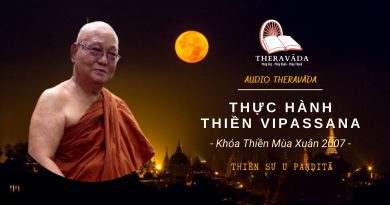Realizing The Eightfold Noble’s Path Through Vipassana Meditation – By Mahasi Sayadaw
Vipassana Meditation – THE METHOD IN BRIEF (BY MAHASI SAYADAW)
Eight Factors Fulfilled
Every time you note “rising,” “falling,” “sitting,” “touching,” “seeing,” “hearing,” “bending,” “stretching,” and so on, an effort is being made. This is the right effort of the Noble Eightfold Path. When you note, you are mindful, which is right mindfulness. Your concentration penetrates the object noted and remains fixed on it, which is right concentration. These three are the concentration constituents of the Path. As you note with concentration, initial application alights onto the object being noted. It is the application of the mind and its concomitants onto the object. Its characteristic is “lifting” of the concomitants onto the object (abhiniropanalakkhana), according to the commentary. This is right thought. Then there is the realisation that the object thus attended to is movement, non-cognition, seeing, cognition, impermanence, and so on, which is right view. Right thought and right view are the wisdom constituents of the Path. The three constituents of morality: right speech, right action, and right livelihood, were perfected when you took up the practice of insight meditation by undertaking the precepts. Besides, there can be no wrong speech, wrong action, or wrong livelihood in respect of the object noted. So whenever you note, you perfect the morality constituents of the Path too.
The eight constituents of the Noble Path occur in every moment of awareness. They constitute the path of insight that arises when clinging is eradicated. You have to develop this path gradually until you reach the knowledge of equanimity with regard to formations. When this knowledge matures, you will arrive at the Noble Path. It is like this: when the knowledge of equanimity with regard to formations has matured and grown strong, your noting gets sharper and swifter. While thus noting with swift awareness, all of a sudden you fall into the peace that is nibbāna . It is rather strange. You have no prior knowledge of it, and you cannot reflect on it when you attain it either. Only after the attainment can you reflect. You reflect because you experienced something unique. This is the knowledge of reviewing (paccavekkhanā-ñāna) . Then you know what has happened. This is how you realise nibbāna through the Noble Path.
If you want to realise nibbāna, it is important to work for freedom from clinging. In the case of ordinary people, clinging arises everywhere — in seeing, in hearing, in touching, and in knowing. They cling to things as permanent, happy, good, as self, ego, or persons. You must work for complete liberation from clinging. To work, means to meditate on whatever arises — whatever is seen, heard, touched, or thought of. If you keep meditating thus, clinging will cease, and the Noble Path will arise, leading to nibbāna. This is the process.
How is insight developed? Insight is developed by meditating on the five aggregates of attachment. Why and when do we meditate on the aggregates? We meditate on the aggregates whenever they arise, so that we do not cling to them. If we fail to meditate on mind and matter, clinging arises. We cling to them as permanent, good, and as self or ego. If we keep meditating on mind and matter, clinging ceases. Then we plainly see that all phenomena are merely impermanent, unsatisfactory, and soulless processes. Once clinging ceases, the Path arises, leading to nibbāna. These are the fundamentals of insight meditation.
Source: http://www.yellowrobe.com/practice/meditation/229-realizing-the-eightfold-nobles-path-through-vipassana-meditation.html







![Videos [khóa Thiền Vipassana 2017] 20. Bài Kinh Thứ Nhất Cho Anada (phần 1) | Thiền Sư U Jatila 7 20 9](https://satima.net/wp-content/uploads/2020/07/20-9-390x205.png)